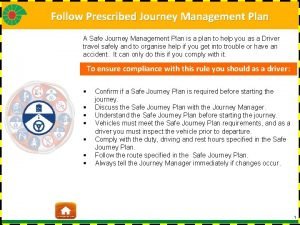Planning my research journey RESEARCH PLANNING Review the






















- Slides: 22

Planning my research journey

RESEARCH PLANNING Review the literature • • Improve your knowledge of your topic Figure out what theoretical position you concur with Select a research approach 1. What type of research will best help me achieve my research purpose?

Get as much information as possible Review the Literature �Read and review the literature on your topic and problem ◦ Write a review ◦ Articulate where you stand with respect to your problem

Select your research tools Design your research Variety of methods to choose from. Which will best help me to get where I want to go?

How Do I Choose a Method? KEY STEPS: 1. What is the purpose of my research? 2. What are my research objectives? 3. What sample will best help me to meet my objectives? 4. How can I best get access and informed consent of subjects or participants?

Clarifying questions Do I want to: �Describe / understand something? �Evaluate? �Figure out: � if and how one behaviour affects another? �People’s attitudes, perspectives, views? �What causes something?

The Scientific Method �An orderly, rigorous process entailing a number of steps: �Recognition & definition of a problem �Formulation of research questions �Collection of data �Analysis and interpretation of data �Statement of conclusions/ interpretations

Why use a Scientific Method? Principles used to guide educational research so to ensure that: Results can be trusted – research was ethical – research was rigorous Results can be reliably used to inform policy and / or practice

Educational Research can be done as either Qualitative Inquiry (understand, describe) Quantitative inquiry (predict, measure, asess, explain, evaluate, show cause and effect or relationships) Mixed Methods (combination of both)

How do I know which one to use? Choose the research approach that will best help you answer the research questions you want to ask. and / or. . .

How do I know which one to use? Choose the research approach that aligns with “your views on what qualifies as valuable knowledge and your perspective on the nature of reality or ontology” (Glesne, p. 4)

Choices of methods for Collecting Data QUANTITATIVE QUALITATIVE DATA SURVEY Historical (Descriptive) Correlational study Observational Causal Comparative studies Experimental Interview Examining Artifacts Analysis of Documents

Quantitative SAMPLE SELECTION Quantitative Examples Specify POPULATION (group of people with same characteristics) Bethlehem 2 nd year Students Select SAMPLE of population to study How many of the total of Bethlehem 2 nd yr students is it feasible and numerically sound to work with? Choose appropriate sampling technique • Simple random; stratified sampling; cluster sampling; systematic sampling. • As large as possible or feasible • Apply statistical formulae to improve likelihood that your sample provides a good estimate of the characteristics of the population Determine SIZE of sample Consider sampling error and

Suggested SAMPLE SIZES �Descriptive Survey Research Designs ◦ At least 100 participants in each group �Causal-Comparative Research Designs ◦ At least 15 participants in each group to be compared �Correlational Research Designs ◦ At least 30 participants �Experimental Research Designs ◦ At least 15 participants in the control group and at least 15 participants in each treatment group.

Site /s & Setting/s �What are best places to find people / places who meet my criteria for a sample? �May be modified due to concerns re: Access ◦ Cost ◦ Time ◦ Other factors ◦ Ethical concerns ◦

Quantitative Instrument Design You can choose: tests; questionnaire; tally sheet; log; observational checklist; inventory; assessment instrument. To measure or assess: performance attitudinal measures behavior To gather factual information

How to design an instrument What will be measured or evaluated? Performance – achievement; intelligence; aptitude; interests; personality assessments Attitudes- surveys; correlational studies; experiments Behaviour – observation checklists

Identifying my Quantitative Instrument �Locate or Develop your own �Modify for cultural relevance �Pilot instrument ◦ Reliability - if it is used again will results be consistent? ◦ Validity – does it measure what it is supposed to measure?

Qualitative Sample Selection Qualitative Sampling Purposeful Examples Select persons or sites who can best help us understand what we are studying. Maximum variation Different types of graduate students Extreme cases Outliers –unique individuals Typical cases Any graduate student Snowballing Follow leads from one participant to identify others Confirming or disconfirming Director of school ; student president Opportunistic Participant who seems suddenly very useful

SAMPLE SIZE of SAMPLE Usually small ; depends on research design and purpose. Examples: Range from 1 to 20 participants Case Study –could be one grade and teacher with 50 students

Site /s & Setting/s What are best places to find people / places who meet my criteria for a sample? �May be modified due to concerns re: ◦ Access ◦ Cost ◦ Time ◦ Other factors ◦ Ethical concerns

Improving my Qualitative Instrument �You are the Instrument �Start being conscious of the lenses you use to “see” and “hear” the data. �Identify your theoretical views �Identify your personal and professional views �Always be mindful of how these may be influencing your data collection and analysis.
 Hình ảnh bộ gõ cơ thể búng tay
Hình ảnh bộ gõ cơ thể búng tay Ng-html
Ng-html Bổ thể
Bổ thể Tỉ lệ cơ thể trẻ em
Tỉ lệ cơ thể trẻ em Voi kéo gỗ như thế nào
Voi kéo gỗ như thế nào Tư thế worms-breton
Tư thế worms-breton Hát lên người ơi alleluia
Hát lên người ơi alleluia Các môn thể thao bắt đầu bằng tiếng nhảy
Các môn thể thao bắt đầu bằng tiếng nhảy Thế nào là hệ số cao nhất
Thế nào là hệ số cao nhất Các châu lục và đại dương trên thế giới
Các châu lục và đại dương trên thế giới Công thức tiính động năng
Công thức tiính động năng Trời xanh đây là của chúng ta thể thơ
Trời xanh đây là của chúng ta thể thơ Cách giải mật thư tọa độ
Cách giải mật thư tọa độ Phép trừ bù
Phép trừ bù Phản ứng thế ankan
Phản ứng thế ankan Các châu lục và đại dương trên thế giới
Các châu lục và đại dương trên thế giới Thơ thất ngôn tứ tuyệt đường luật
Thơ thất ngôn tứ tuyệt đường luật Quá trình desamine hóa có thể tạo ra
Quá trình desamine hóa có thể tạo ra Một số thể thơ truyền thống
Một số thể thơ truyền thống Cái miệng nó xinh thế chỉ nói điều hay thôi
Cái miệng nó xinh thế chỉ nói điều hay thôi Vẽ hình chiếu vuông góc của vật thể sau
Vẽ hình chiếu vuông góc của vật thể sau Thế nào là sự mỏi cơ
Thế nào là sự mỏi cơ đặc điểm cơ thể của người tối cổ
đặc điểm cơ thể của người tối cổ











































